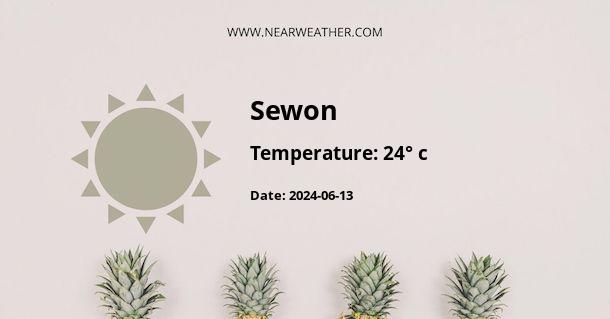Climate and Weather in Sewon, Idaho
Sewon, Idaho is a picturesque town located in the western part of the state. Nestled between the Owyhee Mountains and the Snake River, Sewon experiences a unique climate that is influenced by its geographic location. In this article, we will explore the climate and weather patterns in Sewon throughout the year.
Seasonal Temperatures
Sewon experiences distinct seasons, with each season bringing its own temperature range. Let's take a closer look at the average temperatures throughout the year:
| Season | Average Temperature (°F) |
|---|---|
| Spring | 40-65 |
| Summer | 70-95 |
| Fall | 45-70 |
| Winter | 20-40 |
As the table shows, Sewon experiences a wide range of temperatures throughout the year. Summers can be hot, with average highs reaching the mid-90s, while winters can be cold, with average lows dropping into the 20s. Spring and fall offer milder temperatures, making them popular seasons for outdoor activities.
Precipitation
Sewon receives a moderate amount of precipitation throughout the year, with a slightly higher amount during the winter months. The table below shows the average annual precipitation in Sewon:
| Month | Average Precipitation (inches) |
|---|---|
| January | 1.5 |
| February | 1.3 |
| March | 1.7 |
| April | 1.4 |
| May | 1.6 |
| June | 0.8 |
| July | 0.5 |
| August | 0.4 |
| September | 0.6 |
| October | 0.9 |
| November | 1.2 |
| December | 1.4 |
From the data provided, it is evident that Sewon experiences its highest precipitation levels during the spring months, with March being the wettest month. Summer months typically see less rainfall, with July and August being the driest months of the year. Winter months also receive a moderate amount of precipitation, with an average of 1.4 inches in December.
Snowfall
Due to its location in the western part of Idaho, Sewon experiences snowfall during the winter months. The table below shows the average snowfall in Sewon:
| Month | Average Snowfall (inches) |
|---|---|
| November | 3.0 |
| December | 5.6 |
| January | 7.2 |
| February | 6.8 |
| March | 5.4 |
| April | 1.3 |
As the table shows, Sewon receives its highest snowfall amounts during the winter months, with January having the highest average snowfall of 7.2 inches. Snowfall gradually decreases as spring approaches, with April receiving the least amount of snowfall.
Extreme Weather Events
While Sewon generally experiences mild weather conditions, it is not immune to extreme weather events. Thunderstorms can occur during the summer months, bringing heavy rain, lightning, and gusty winds. Occasionally, these thunderstorms can turn severe, with the possibility of hail and tornadoes.
In winter, Sewon can experience winter storms that bring heavy snowfall and strong winds. These storms can lead to hazardous travel conditions and temporary closures of roads and highways.
Conclusion
Sewon, Idaho experiences a diverse range of weather throughout the year. From hot summers to cold winters, and from wet springs to snowy winters, Sewon offers a variety of weather conditions for its residents and visitors to enjoy. It is important to stay informed about the local weather conditions and be prepared for any extreme weather events that may occur. Whether you're planning outdoor activities or simply want to dress appropriately, understanding Sewon's climate and weather patterns can help you make informed decisions.
A - Sewon's Latitude is -7.876390 & Longitude is 110.358887.
A - Weather in Sewon is 27° today.
A - Climate Conditions in Sewon shows overcast clouds today.
A - Humidity in Sewon is 77% today.
A - Wind speed in Sewon is 12.02 km/h, flowing at 58° wind direction. today.
